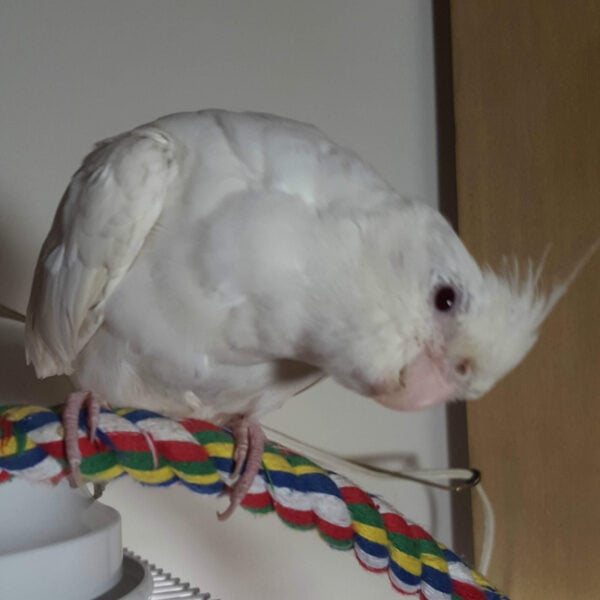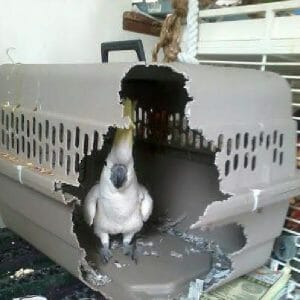Last Updated on by Mitch Rezman
Hi Randall
I’m looking at the pictures you sent, thank you.
Obviously, the birds have feather self-destruction issues.
Typically these need to be addressed holistically.
Before we get granular on the issue let’s do some housekeeping and talk about this particular species.
About 20% of parrots are sexually dimorphic meaning you can determine the sex of the bird by its color or markings.
Eclectus parrots are either red and blue (female) or green (male).
Male ringnecks have the ring, females have none.
Color is a brilliant evolutionary touch.
The dark red and blue colors of females are so that they easily hide deep in the hollows of trees averting predators’ eyes.
The green males are easily hidden by leaves in the treetops where they spend their day foraging for food.
An interesting footnote is that neither the male nor the female is monogamous.
A brooding Eclectus hen will offer herself up to almost any male who provides yummy regurgitation.
Now to the heart of the matter, pet bird care for this Australian parrot couple.
We’ll start with an evaluation of:
- Nutrition
- In the cage environment
- Out of the cage environment
- Lighting
General health and well-being including subjects like bathing.
My general diagnosis is that these birds are malnourished, bored, and stressed.
Kudos for taking the birds in from the environment that caused this.
From the picture with the male and female in the same cage, there’s a host of problems that need to be addressed inside the birdcage’s environment.
Bird cages in a perfect world should be placed in a corner where two sides of the cage are protected by walls. Parrots are prey animals and they like their privacy.
Here they are fully exposed plus they are in front of a window.
Birds don’t understand the meaning of glass which is why they fly into it and can get disturbed or stressed by seeing predatory birds and animals like cats outside, on the other side of the window.
We have done things like adding a board using cable ties 2 at the very least black off the back of the cage.
This is our cockatiel cage and if you look toward the bottom you’ll see it’s actually pick up to a white chimney in our living quarters.
Although he has three exposed sides, to the north he can look at the other two birds
To the west, he sees me at my desk most of the time.
He spends his time with the other two birds downstairs in our front office entertaining pedestrian traffic from 10 am till 4 pm.
At night we light up the south end of the upstairs space and for the most part, he’s out of his cage where he can pick and choose where to land next.
Your Eclectus parrots are (cage) captive, have no foraging or enrichment opportunities in the form of bird toys, and are sleeping on hardwood perches that are stressful on their feet all of which are plucking triggers.
The first thing to do is cover the window, blinds, newspaper a sheet – anything.
I know you have at least one other bird, a macaw maybe?
Even if all the birds are kept in their cage, should they escape during feeding or cage cleaning time, the window would present an opportunity for serious injury when flown into.
A Better Bird Ep 13 How Bird Proof Is Your Home ~ Video
Eclectus are renowned for growing long malformed beaks when fed strictly a seed diet.
I don’t think pellets are the answer.
I would go with Higgins safflower gold parrot size no sunflower 3 lb (1.361 kg)
It’s a blend of seeds fruits nuts and wait for it – pellets.
It would easily be your first move towards forging and enrichment.
Coconut oil, nuked for five seconds can be poured over any seed or pellet mixture once cooled to the touch.
That simple hack will help moisturize your bird’s two major integumentary systems ~ skin and feathers.
Treats like Nutriberries and Avi-cakes will extend the relationship with food.
Every night 15 minutes before our bird’s lights go out they get a nummy, birdie bedtime snack.
Keto the ringneck and Chili the quaker each kit about a half-inch square of Avi-cakes which is comprised of 50% pellets.
Even though it’s got small seeds in it birds enjoy the flavor because it is bound with molasses which provides a nice low level of sweetness, for palatability, without sugar.
Let’s move on to inside the cage and I’m going to cruise by this quickly because we have so many things to talk about.
Earlier I mentioned that parrots are prey animals and are more comfortable and secure when they feel they are not exposed to the world.
A parrot’s birdcage should have 10 to 30 toys in the top ⅓ of the captive environment.
This allows for forging, enrichment, and privacy.
The toys become a privacy canopy much like the Rainforests in Australia of which Eclectus parrots are indigenous.
Read more about the cage canopy effect here.
At least two Booda soft rope perches should be installed in the upper 1/3 of the cage for the birds to sleep on.
One or two more should be added mid-level.

Fabric perches have the benefit of being soft on a bird’s feet, especially with foot pain to be plucking trigger.
More importantly, the birds can pluck at the soft rope fiber as an alternative to their own feathers.
If the birds are ever left out of the cage where do they go?
If it’s on top of the cage are there toys to keep them entertained in food to keep things interesting?
Are there any play stands available within the room in the pictures or the home, in general, are comfortable when they are out of the cage.
A $200 side chair that can be shredded into toothpicks in the blink of a bird’s eye, is never a good option.
I have always felt in awe of caring for an animal that can live for decades.
Rapid swings of weight over 30 days can be an indicator of illness or the production of eggs.
Parrots, especially pluckers should be based on a regular basis.
A spray bottle or a sink bath will enhance feathers and skin hydration.
Reach out should you have further questions.
Stay safe
Best
MitchR.
Author Profile
Latest entries
 The Traveling BirdJune 26, 2025Can You Name 5 Parrot Species That Are Living Wild in the USA?
The Traveling BirdJune 26, 2025Can You Name 5 Parrot Species That Are Living Wild in the USA? Bird BehaviorJune 26, 2025How is it Parrots Are Problem Solvers Social Animals and Even Use Tools?
Bird BehaviorJune 26, 2025How is it Parrots Are Problem Solvers Social Animals and Even Use Tools? Bird & Parrot AnatomyJune 25, 2025How a Tiny Chemical Modification Makes Parrots Nature’s Living Paintings
Bird & Parrot AnatomyJune 25, 2025How a Tiny Chemical Modification Makes Parrots Nature’s Living Paintings PigeonsJune 20, 2025How Do Parrots Thrive in Cities Outside Their Native Habitats?
PigeonsJune 20, 2025How Do Parrots Thrive in Cities Outside Their Native Habitats?





Mary Farley
7 Feb 2021Hi, I have had eclectus parrots for 25 years and have dealt with plucking issues and it has mainly come from the wrong diet though everything you mention in the article contributes to plucking from stress and boredom. Eclectus should be fed a pelleted food that is low in fat with an abundance of fresh vegetables and fruits with sprouted or cooked grain and no dyes or added vitamins in any of their food. They cannot handle excessive seed or fat. Laurella Desborough has bred Eclectus for years and has recommendations for feeding on her website. Had a consultation with her about 15 yrs ago when my Voss started plucking and I changed the diet according to her recommendations. Took 6 months to turn around but it did. I also suggest you consult with an avian vet such as Dr. Quesenberry who has been an avian vet for decades. She has several research articles about Eclectus and is well worth paying for a phone consultation with her or one of her staff. Their number is (212) 838-8100. Avi cakes, nutriberries, and a lack of fresh vegetables and fruit will dramatically shorten the life of your birds. The eclectus is very different than other parrots in aviculture and you should really talk to a professional about the proper diet and care of these birds. Good luck and all the best ,they are absolutely the best birds.
laurelladesborough
11 Feb 2021First of all, we do not recommend that two pet eclectus share the same cage. A pet cage is generally not large enough for two eclectus parrots, in terms of their genetic program regarding territory and space. So, separate cages are a must for happy pet eclectus. Second, eclectus parrot diets should never include items like Nutriberries and other commercial bird treats, due to the problem caused by the bird ingesting an excess of man made vitamin A in those items, (per avian research on commercial parrot foods). Eclectus that consume Nutriberries often end up with severe muscle spasms, known as toe tapping and wing flipping. Fresh foods are critical for eclectus parrots because they do need the roughage provided by fresh foods, as their digestive system requires it. Research done by Dr. Rob Marshall indicates just how different their digestive system is when compared to other parrot species. Of course, a variety of toys is important for pet birds. In the case of eclectus parrots, a soft wood perch is important as these birds are then able to groom their beaks by chewing on soft wood. When safe tree branches are not available, an untreated 2×2 from the lumber store works well and provides the birds with the opportunity to exercise their need to chew wood. Eclectus parrots make wonderful pet birds, but they do require certain specifics re diet and caging in order to be healthy and happy.